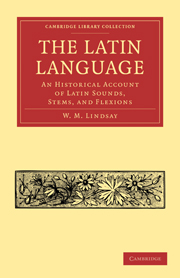Book contents
- Frontmatter
- PREFACE
- Contents
- LIST OF ABBREVIATIONS
- CHAPTER I THE ALPHABET
- CHAPTER II PRONUNCIATION
- CHAPTER III ACCENTUATION
- CHAPTER IV THE LATIN REPRESENTATIVES OF THE INDO-EUROPEAN SOUNDS
- CHAPTER V FORMATION OF NOUN AND ADJECTIVE STEMS
- CHAPTER VI DECLENSION OF NOUNS AND ADJECTIVES. COMPARISON OF ADJECTIVES. NUMERALS
- CHAPTER VII THE PRONOUNS
- CHAPTER VIII THE VERB
- CHAPTER IX ADVERBS AND PREPOSITIONS
- CHAPTER X CONJUNCTIONS AND INTERJECTIONS
- INDEX
- ADDENDA ET CORRIGENDA
CHAPTER X - CONJUNCTIONS AND INTERJECTIONS
Published online by Cambridge University Press: 05 August 2011
- Frontmatter
- PREFACE
- Contents
- LIST OF ABBREVIATIONS
- CHAPTER I THE ALPHABET
- CHAPTER II PRONUNCIATION
- CHAPTER III ACCENTUATION
- CHAPTER IV THE LATIN REPRESENTATIVES OF THE INDO-EUROPEAN SOUNDS
- CHAPTER V FORMATION OF NOUN AND ADJECTIVE STEMS
- CHAPTER VI DECLENSION OF NOUNS AND ADJECTIVES. COMPARISON OF ADJECTIVES. NUMERALS
- CHAPTER VII THE PRONOUNS
- CHAPTER VIII THE VERB
- CHAPTER IX ADVERBS AND PREPOSITIONS
- CHAPTER X CONJUNCTIONS AND INTERJECTIONS
- INDEX
- ADDENDA ET CORRIGENDA
Summary
§ 1. CONJUNCTIONS. As Prepositions are hardly separable from Adverbs of Locality, so Conjunctions are closely connected with pronominal Adverbs. These pronominal Adverbs, as we have seen (ch. ix. § 10), are not always capable of being referred to their proper case-form (e. g. ȋbī, ŭbī), owing to our imperfect knowledge of the declension of the I.-Eur. pronoun. Nor is it easy to find their cognates in the various I.-Eur. languages; so rapidly does the meaning of a Conjunction alter. Thus Latin ĕnim, which in the older literature is a particle of asseveration, ‘indeed,’ had by the classical period appropriated the sense of ‘for’; and in French, pas (Lat. passus) and point (Lat. punctum) have acquired a negative sense from their use in the phrases ne … pas, ne … point. A feature of I.-Eur. Conjunctions is their tendency to append other Conjunctions or conjunctive Particles (e. g. ὡς in Greek may append δή, περ, &c., ὡς δή, ὣς περ); and this habit puts another obstacle in the way of identifying cognate Conjunctions in different languages, for in one language they may appear extended by one particle, in another language by another. The exact form of these conjunctive Particles is also a difficult thing to ascertain; we often see parallel stems in -o, -i, -u, &c.
- Type
- Chapter
- Information
- The Latin LanguageAn Historical Account of Latin Sounds, Stems, and Flexions, pp. 596 - 618Publisher: Cambridge University PressPrint publication year: 2010First published in: 1894



